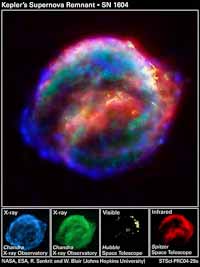

Supernovae
Supernovae are stellar explosions that typically result when large stars exhaust their nuclear fuel and contract in free-fall collapse. Supernovae are extremely bright, often brighter than an entire galaxy, before disappearing from view in a few weeks or months.During the explosion, runaway nuclear reactions create neutrons which combine with elements from the core to produce vast quantities of additional chemical elements. The explosion's shockwave scatters these supernovae remnants at velocities of up to a tenth the speed of light into the interstellar medium, where it mixes with hydrogen and other elements to seed the next generation of stars.
Supernovae are bright and can be seen at great distances and their characteristic light emissions analyzed. Large earth-based telescopes and those on satellites have enabled astronomers to greatly refine and extend the range and precision of Hubble redshift measurements and better understand supernovae compositions.
Modern comprehensive automated imaging surveys have greatly increased the early detection of supernovae, making it possible to learn more about their nuclear chemistry and better determine their distances and frequency of occurances. In a galaxy the size of our Milky Way, it has traditionally been estimated that a supernova occurs about every 50 years.
Hou-han-shu (Astronomical treatise, Ch.22)